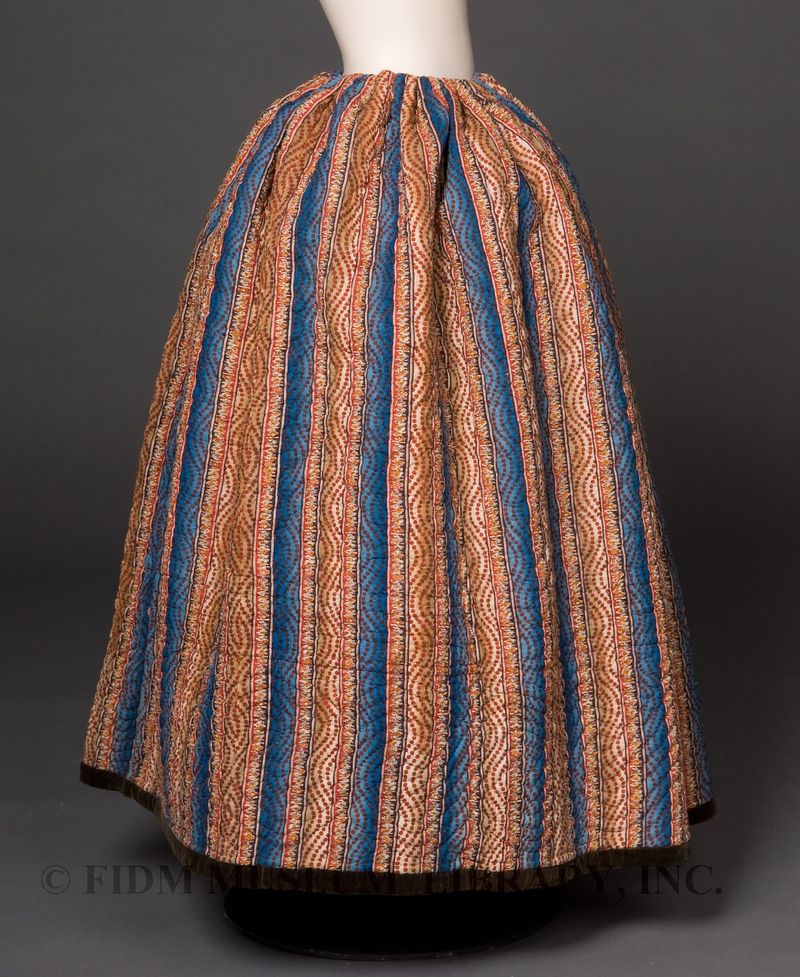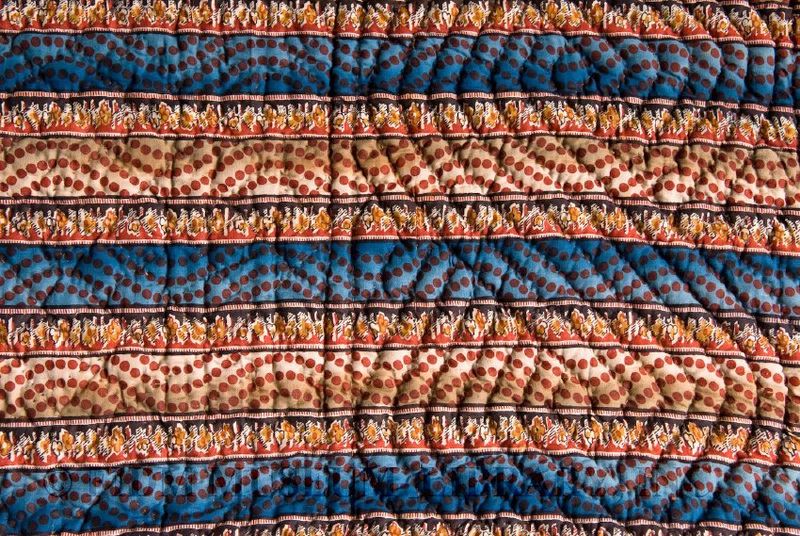Before the introduction of the cage crinoline in 1856, women typically wore multiple layers of petticoats. The petticoat layers (sometimes as many as 6!) not only shaped the skirt into a fashionable bell-shape, but also provided warmth. Between about 1825-1850, petticoats with elaborate quilting were fashionable. Called “quilted coats,” “wearing quilts” or “quilts,” these petticoats were simply large quilts meant to be worn on the body. They were often created in the same manner as bed quilts, with women working together to complete the patterned stitching. After stitching up the single, vertical back-seam and gathering the drawstring waist, the quilted petticoat was ready to be worn.
 Quilted petticoat
Quilted petticoat
c. 1840-45
Gift of Anna Bing Arnold
2003.795.12
Quilted petticoats of the 19th century were a revival of the 18th century fashion for quilted petticoats. Many styles of 18th century dresses feature a split front skirt, which was worn over a petticoat of matching or contrasting fabric. Because they were meant to be seen, 18th century petticoats often feature amazingly detailed quilting, with elaborate scenes featuring animals or intricate geometric patterns.
The brightly colored and patterned cotton textile identifies this petticoat as being from the 19th, rather than the 18th, century. The dense patterning of multicolored stripes and serpentine polka dots is typical of printed cottons from the 1840s. It was produced by roller printing, a process developed in the late 18th century. In roller printing, a metal cylinder is engraved with the desired pattern and rolled over the fabric. This process allowed for very small scale, detailed and intricate textile designs. If required, additional imagery could be block-printed by hand over the roller printed pattern.
This view clearly demonstrates the quilt-like structure of this petticoat. The maker even used a variety of fabrics, as in a patchwork quilt. In a pinch, a 19th century woman could have used this as a bed covering. In the midst of this cold December, a “wearing quilt” sounds very appealing!
Baumgarten, Linda. What Clothes Reveal: The Language of Clothing in Colonial and Federal America. Williamsburg, VA: The Colonial Williamsburg Foundation. 2002.




I can just imagine this in the heat of an Australian summer! But can appreciate the work that has gone into it.
I would wear this right now…and I’m in San Diego. Not sure I would leave the house in it, but I’m in for the night anyway!
It’s so depressing how little work goes into fashion today. Everything is so disposable and rarely lasts more than one or two seasons. And truly, there is no dress in this modern age that is meant to be worn more than once.
Can you imagine a Hollywood starlet wearing something repeatedly and being proud of its craftsmanship as well as its usefulness?
Seeing this intensely worked piece makes me wish the world had a stronger commitment to quality and the hard work it takes to produce it!
Beautiful. We modern women don’t get to enjoy such finely worked pieces as part of our undergarments. But they must have been awfully heavy! Wonder if those women had sore hips from carrying around the weight of up to 6 quilts on themselves all day?
Di, this quilted petticoat would be a terrible thing to wear in the summer…makes me sweat to think about it! Something of this weight would have been worn during the colder months.
CeCelia, I should clarify that petticoats of this weight probably would have been worn one at a time, or possibly with one or two lightweight petticoats. You’re right in thinking that 6 layers of quilted petticoat would be too much.
Becky, I agree with you! The throwaway nature of mass-market fashion and the entire fashion system is a bit discouraging. Wonder if the current economy will change this…
It is fun to see how the desire of a woman to wear something pretty for herself under her clothes was interpreted in earlier periods.
Rosemary, I agree! There is no practical or functional reason for the colorful fabric or intricate quilting. It was surely inspired by the desire for a bit of secret luxury, which would be known only to the wearer. And probably the friends that helped her quilt the petticoat!
The amount of work and skill and patience to stitch one of these petticoats is staggering. No wonder they would ‘hitch’ up their skirt to let it show.
Perhaps this explains, in part, the willingness of my almost-teenage daughter, to let her pretty bra straps and all those camies show!
Maybe we haven’t changed all that much.
Would a quilted petticoat be worn over a crinoline?